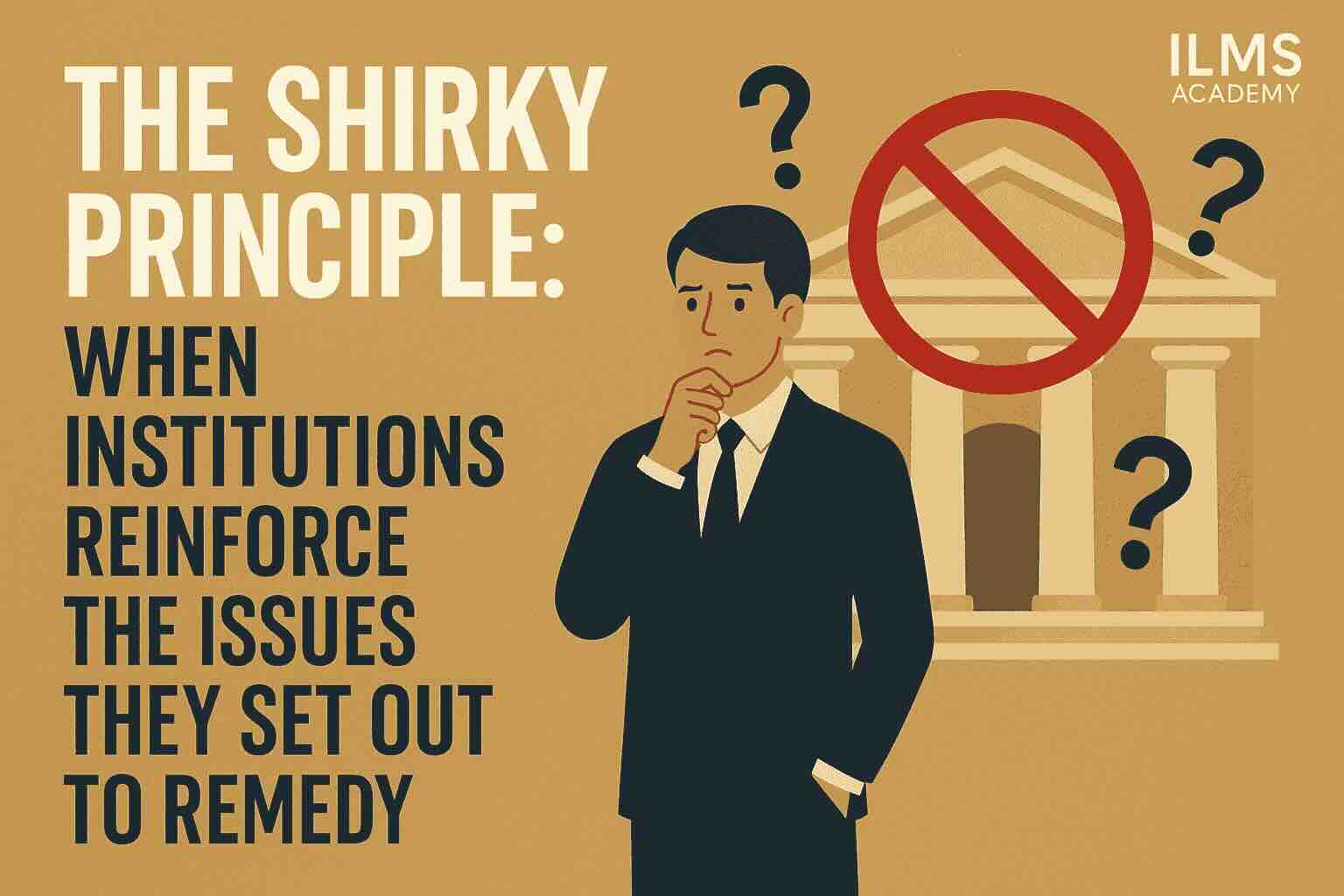The Shirky Principle: When Institutions Reinforce the Issues They Set Out to Remedy

Table of Contents
- Introduction
- In-Depth Analysis: Deciphering the Dynamics of Institutional Inertia
- The Consequences of the Shirky Principle on HR Policies and Practices
- Illustrative Examples of the Shirky Principle Applied to HR Practice
- Strategies for Overcoming Institutional Inertia and Achieving HR Agility
- Conclusion: Adopting Adaptive HR for Sustainable Organizational Success
The Shirky Principle: When Institutions Reinforce the Issues They Set Out to Remedy
The Shirky Principle, as outlined by social media theorist Clay Shirky, is a critical theory of institutional behavior that explains that “institutions will try to preserve the problem to which they are the solution.” This principle shows a basic truth about organizational dynamics: institutions tend to have a vested interest in keeping things the way they are, even if that means perpetuating the very problems they were established to solve. This natural resistance to change can afflict institutions, especially those that have entrenched power structures and established bureaucracies.
This resistance is rooted in a convergence of motivations such as fear of losing influence or obsolescence, desire to preserve familiar processes, lack of incentives to topple existing structures, and inertia of established systems. The Shirky Principle especially applies in functions such as Human Resources (HR), where aged policies and processes can entrench inefficiencies, suppress innovation, and limit organizational responsiveness, finally leading to a cycle of stagnation.
In-Depth Analysis: Deciphering the Dynamics of Institutional Inertia
A number of factors are responsible for the expression of the Shirky Principle:
-
Vested Interests and Power Relations
- Institutions and those in them develop a vested interest in the issues they solve, and hence a sense of ownership, which makes them want to preserve the status quo.
- Change disrupts established power relations and resource distribution.
- The people who gain the most from the system are usually the most opposed to change, using their power to preserve their benefit.
-
Bureaucratic Inertia and Routines Enshrined
- Pre-existing routines and procedures become firmly entrenched, making them feel normal and predictable. This inertia hinders the ability to introduce change, even when it is obvious that it is necessary.
- The sheer amount of paperwork and the complexity of the system build a barrier to change.
-
Fear of the Unknown and Risk Aversion
- People and organizations can be resistant to change because they fear the unknown or loss of power or resources.
- This fear of risk holds back innovation and hinders adaptation to evolving conditions.
-
Lack of Incentives and Accountability
- There is a potential absence of incentives to upset established structures or solve root issues.
- In other situations, people can even be punished for going against the status quo.
- Absence of accountability for the system per se, provided that people behave according to rules, ensures that the issue continues.
-
Sunk Cost Fallacy and Cognitive Dissonance
- Due to the massive investment in the existing system, individuals do not want to switch it, even if it’s no longer performing. This is the sunk cost fallacy.
- Individuals justify the existing system to avoid cognitive dissonance, even when they’re aware that it is not performing.
-
Information Asymmetry and Control
- The most powerful have the most information and might not share it in order to preserve their power.
- This information asymmetry is a source of imbalance that makes change hard.
</style>
The Consequences of the Shirky Principle on HR Policies and Practices
The Shirky Principle is realized in HR by:
- Certificate Course in Labour Laws
- Certificate Course in Drafting of Pleadings
- Certificate Programme in Train The Trainer (TTT) PoSH
- Certificate course in Contract Drafting
- Certificate Course in HRM (Human Resource Management)
- Online Certificate course on RTI (English/हिंदी)
- Guide to setup Startup in India
- HR Analytics Certification Course
-
Dated and Inapplicable Policies
- Policies are not effective in keeping up with the changing workforce needs and the business environment, causing worker dissatisfaction and legal issues.
-
Bureaucratic Inefficiencies and Process Bottlenecks
- Highly time-consuming and complex HR processes prevent efficiency and productivity, slowing down hiring, onboarding, and other important functions.
-
Lack of Agility and Adaptability
- HR functions fail to keep pace with evolving business demands, which makes it difficult for the organization to react to changes in the market and competitive forces.
-
Employee Disengagement and Dissatisfaction
- Inefficient and outdated HR policies contribute to employee dissatisfaction and disengagement, negatively affecting morale and productivity.
-
Talent Acquisition and Retention Issues
- Inflexible HR policies discourage highly skilled candidates from joining the company.
- This makes it difficult for the organization to assemble a high-performing team.
Illustrative Examples of the Shirky Principle Applied to HR Practice
-
Performance Appraisal Systems
- Companies hold on to yearly performance appraisals, even though they fail to work, simply because they are an accepted and well-established procedure.
-
Recruitment and Onboarding Processes
- Inefficient and lengthy hiring procedures drive away skilled candidates, yet are kept since they are viewed as “extensive.”
-
Training and Development Programs
- Ancient training programs continue since they have already been formulated and budgeted for, despite them being no longer useful.
-
Benefits Administration and Employee Records
- Outdated paper or digital systems continue to be used due to the perceived expense and labor involved in changing to new systems.
-
Disciplinary and Grievance Procedures
- Excessively punitive procedures continue in operation because they are regarded as a means of retaining control, although they generate a negative work environment.
</style>
Strategies for Overcoming Institutional Inertia and Achieving HR Agility
In order to overcome the Shirky Principle, organizations need to:
-
Periodically Review and Refresh Policies
- Periodically review HR policies and processes for their relevance and effectiveness.
-
Adopt Technology and Digital Innovation
- Apply technology to automate HR processes and enhance data analytics.
-
Foster an Innovative and Experimentation Culture
- Encourage HR professionals to experiment and adopt agile methods.
-
Prioritize Employee Feedback and Engagement
- Collect frequent feedback from employees regarding HR policies and practices.
-
Empower HR Professionals and Decentralize Decision-Making
- Provide HR professionals with the freedom to make decisions and function as strategic partners.
-
Focus on Outcomes and Strategic Alignment
- Align HR initiatives with the overall business goals of the organization.
-
Data-Driven Decision-Making and Analytics
- Leverage data analytics to detect inefficiencies and quantify the effect of HR initiatives.
-
Foster Cross-Functional Collaboration
- Assemble teams consisting of individuals from numerous departments.
Conclusion: Adopting Adaptive HR for Sustainable Organizational Success
The Shirky Principle emphasizes the need for organizations to work actively against institutional inertia. By breaking down bureaucratic inefficiencies, cultivating an innovative culture, and focusing on employee engagement, HR departments can become strategic collaborators that contribute to organizational success. In the age of fast change and disruption, adaptability and responsiveness are no longer luxuries but necessities for survival. By adopting these values, organizations can be certain they are not causing the issues they were designed to eliminate, but adapting to overcome the challenges of tomorrow.
To overcome the limitations of institutional inertia, organizations need to develop a culture of on-going improvement and strategic adjustment. This requires a move away from reactive problem-solving towards proactive innovation, with HR policies being reviewed, revised, and aligned with changing workforce and organizational needs on a regular basis. Adopting technology and digital change is essential to simplify processes, automate administrative functions, and improve data-driven decision-making.
In addition, promoting a culture of experimentation and innovation enables HR professionals to think outside the box, experiment with new concepts, and embrace agile practices. This involves establishing a safe environment for experimentation, where mistakes are seen as opportunities for learning and not as failures. Prioritizing employee input and participation is also critical in order to ensure that HR policies are responsive, relevant, and representative of the needs of the diverse workforce. By proactively soliciting the views of employees and using them in policy-making, organizations can create a more inclusive and fairer workplace.
- Certificate Course in Labour Laws
- Certificate Course in Drafting of Pleadings
- Certificate Programme in Train The Trainer (TTT) PoSH
- Certificate course in Contract Drafting
- Certificate Course in HRM (Human Resource Management)
- Online Certificate course on RTI (English/हिंदी)
- Guide to setup Startup in India
- HR Analytics Certification Course
Enabling HR professionals and decentralizing decision-making are essential actions in breaking down bureaucratic obstacles and driving agility. This means giving HR teams the autonomy and resources to make informed decisions and drive change. By aligning on outcomes and strategy, organizations can guarantee that HR initiatives are driving direct contributions to the attainment of business goals.
Finally, the Shirky Principle emphasizes the need to develop adaptive and robust institutions that can handle the dynamics of a rapidly changing world. By adopting an anticipatory and transformative HR approach, organizations can escape the vicious cycle of recreating the same problems and establish a platform for enduring success. Anticipation and responsiveness to change are not just sources of competitive edge; they are essential requisites for long-term survival and prosperity.
- Certificate Course in Labour Laws
- Certificate Course in Drafting of Pleadings
- Certificate Programme in Train The Trainer (TTT) PoSH
- Certificate course in Contract Drafting
- Certificate Course in HRM (Human Resource Management)
- Online Certificate course on RTI (English/हिंदी)
- Guide to setup Startup in India
- HR Analytics Certification Course
